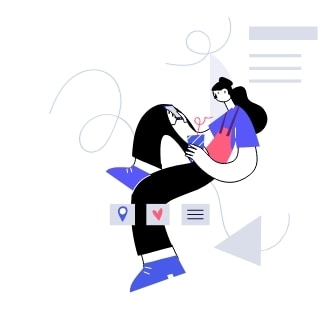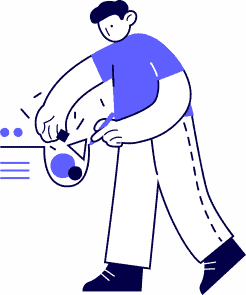
Enhance Your Design Thinking Skills In 4 Minutes!
71% of organizations that practice design thinking report that it has improved their working culture on a team level.
10% of the Fortune 500 have stated that design is their No. 1 priority.
50% of design-led companies report more loyal customers as a benefit to having advanced design practices.
Sounds like a game changing magic trick, doesn’t it? So these three facts are witnesses of what wonders Design Thinking can do.
But just like we have appetizers before the main course, what needs to addressed before the hacks of Design Thinking, is:

What is Design Thinking?
Design Thinking, in the simplest of words, is creative problem solving, having a human-centered core. It mainly involves questioning and challenging the conditioned pattern of thinking.
In other words, Design Thinking is a non-linear process of creative or innovative thinking, or thinking ‘out of the box’. Companies that foster creativity enjoy 1.5 times greater market share.
Did you know?
Design-led firms consciously put the customer first, with 46% of design leaders citing an emotional bond with customers as a defining characteristic of advanced design practice.
Design Thinking helps us in the process of questioning: questioning the problem, the assumptions, and the implications. It tackles problems that are ill-defined or unknown, by re-framing them in human-centric ways, creating ideas in brainstorming sessions, and adopting a hands-on approach in prototyping and testing. It also involves sketching, prototyping, testing, and trying out concepts and ideas.
Phases of Design Thinking
There are many variants of the Design Thinking process in use today and they have from three to seven phases. Here, we’ll focus on the five-phase model proposed by the Hasso-Plattner Institute of Design at Stanford. The five phases of Design Thinking are as follows:
1. Empathize:
Design Thinking largely relies upon profound interest in understanding and empathizing with the target users. In other words, stepping into the shoes of the user is what helps a designer to meet the users’ requirements and expectations.
As designers, we can use psychology to build more intuitive, human-centered products and experiences.
Instead of forcing users to put up with the design of a product or experience, we need to empathize with the users. We psychologically have a schema or a mental model of everything.
Therefore, if a designer wants to design a social media app, it’s very important that the designer’s mental model of the app matches that of the user.
Only then will the user be satisfied with it.
2. Define:
“ A problem well stated is a problem half solved.”
This quote by Charles Kettering precisely sums up the chief objective of defining the problem faced by the user because defining the problem provides the designer with immense clarity.
3. Ideate:
Ideation involves challenging assumptions and creating ideas for innovative solutions to the defined problem in different ways, one of the most popular ones being brainstorming sessions.
As this stage involves thinking out of the box, the question that stares at us right in the face is how to think out of the box?
How to break the conditioned pattern of thinking?
Here are a few hacks!
Challenge what is obvious.
Let’s take an example:
Why did we never realize that the tongue rests at the top of our mouth?
How many of you reading this realized it at this moment?
Well, we would’ve realized earlier if we had an eye for some not-so-obvious things and challenged our conditioned assumption of gravity!
What we sometimes assume to be obviously impossible, turns out to be possible when we challenge our assumptions.
Determine your desired end result.
The human brain has the ability to connect anything to everything.
Can’t believe it?
Pick any random sentence from a book and another random sentence from somewhere else.
Start writing from one of the two sentences and aim to finish a sensible write up with another.
Could you do it?
Of course, you could!
The human brain is full of surprises!
The start of Design Thinking doesn’t necessarily need to begin with empathizing. It can begin with any of the five phases. If you determine the result you want, after some brainstorming, your brain will manage to draw a connection between the start and the end! However, a little flexibility won’t do any harm.
Take a break!
During the Nineteenth Century, many scientists and chemists had already described the structure of the chemical compound Benzene, but nobody was able to discover and draw the exact structure of it.
The German organic chemist August Kekule is interestingly known to have discovered the cyclical structure of the famous chemical compound Benzene through his dream, which had a snake biting its tail!
The backstory is that, despite the conspiracy buffs that refuse to give Kekule the credit for it, Kekule had been trying to discover the structure of Benzene for a long time. When he finally gave up all hope and stopped foraging for it, one fine night, he saw a snake biting its tail in his dream, and the cyclical structure of Benzene just happened to click!
Therefore, taking a break from something that has been occupying your brain allows it to settle down, and having your subconscious mind process it can do wonders!
4. Prototype:
Prototyping involves starting to create models of solutions.
5. Test:
This stage is where the real execution of the ideas created in ideation occurs.
In a world where 69% of design-led firms perceive the innovation process to be more efficient with design thinking, you now know every basic thing there is to know about Design Thinking.
82% of companies believe there is a strong connection between creativity and business results. Knowing and applying the creativity hacks here can help you have a great kick start in any domain you choose!
Time to stop contemplating and start some Design Thinking! If you need any help, do connect with Leo9 Studio| UI UX Design Agency.
CHECK OUT MORE AWESOME BLOGS:
Find Out The Shocking Truth About Brand Purpose
Create your business purpose today. The only way to survive your business for the long term is to stick to your brand purpose.
6 Reasons Why Most Mobile App Design Fails
Know your mobile app design and development issues to evaluate and exclude the most common mistakes designers and developers make.





